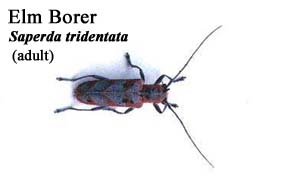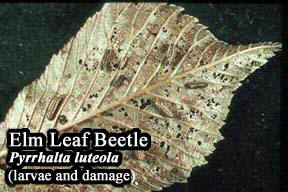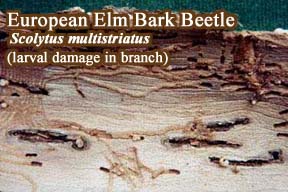Elm (Ulmus)
Plant Health Problems
Diseases caused by Fungi:
Dutch elm disease, Ophiostoma novo-ulmi.
This disease has important historical significance, especially here in Connecticut. The causal fungus is carried in the mouth and on the bodies of the elm bark beetle, and trees are inoculated during feeding in the early spring. In August, wilting and dying of leaves on small to large branches (referred to as flagging) may be seen in the canopy and reddish-brown streaks are occasionally found in the sapwood. The fungus proceeds through the vascular system of the tree and can kill a large tree in three or four years.
For control of the disease, the best course is to control the elm bark beetles (see below). Branches with symptoms should be pruned 10 feet below symptoms in order to prevent spread of the fungus in the tree. dead trees should be promptly removed from areas with living elms, as beetles carrying the fungus may emerge from galleries in the dead bark in the spring. A number of new cultivars are available with some resistance to this pathogen. In the past, injection of the trunk with fungicide was recommended, but the wounds produced by injection are often invaded by other pathogens causing more damage. For more information, see the fact sheet on Elm Information for Connecticut.
Wilt, Verticillium albo-atrum.
This is responsible for the death of many street trees and can also kill forest trees growing in poor sites. The fungus enters the tree through the roots, and spreads throughout the tree. Dark streaks can occasionally be seen in the vascular system by cutting away the bark. Wilting and defoliation are followed by general decline and death of the tree. The fungus may infect susceptible species planted as replacements, and care should be taken to use only resistant trees such as conifers, gingkos, beech, sweet gum, and willows.
Maintaining tree vigor with adequate water during dry seasons and applications of fertilizer in the spring can help the trees resist the pathogen or prolong the life of the tree once infection has occurred.
Black spot, Stegophora ulmea.
Small, yellow spots first appear on upper leaf surfaces early in the season. These spots gradually darken and finally appear as raised, black spots with yellow haloes. When they are numerous, the spots coalesce and cause some distortion of the leaf. In wet years, lesions may also develop on petioles and succulent stems. Severe infections can result in near-complete defoliation by early August.
Control can be achieved by raking and removing fallen leaves and by pruning and removing symptomatic twigs or stems. It is also helpful to maximize tree vigor by fertilizing and watering. Chemical controls can be effective when infection is severe. Among the compounds registered for use in Connecticut is mancozeb. Applications should be made when the new growth emerges in the spring. Consult the label for dosage rates and safety precautions.
Diseases caused by Bacteria:
Bacterial wetwood and slime flux, several species of bacteria and yeasts.
Symptoms are vertical light or dark streaks in the bark where liquid seeps out of cracks and runs down the bark. On the plant surface the liquid supports growth of many kinds of bacteria, yeasts, and fungi that give it a slimy texture and an often fetid odor. This is usually not a serious problem for the health of the tree, but can devalue lumber. Flux with a fermentative odor is called alcoholic flux and is caused by fermentation of sap in shallow wounds.
There are no effective chemical controls.
Diseases caused by Phytoplasmas:
Elm yellows or elm phloem necrosis, phytoplasma.
Symptoms are similar to Dutch elm disease, but no streaks are found in the sapwood. The inner bark may turn yellow, and give off a smell of oil of wintergreen. Trees may die rapidly.
Although there are no known cures, it can be helpful to maximize the vigor of the tree by attention to watering and fertilizing.
Insect Problems:
Cankerworms, Alsophila pometaria and Paleacrita vernata.
Canker worms often partially defoliate elm trees. When these measuring-worms or inch-worm caterpillars are abundant, they may defoliate the trees. In early spring, caterpillars hatch from the eggs laid on the trees in late fall or early spring. Older caterpillars are black or greenish with stripes. The male moths are gray with a wingspread of 1"; the female moths are wingless. Each species has only one generation a year. The abundance of cankerworms varies in cycles. The caterpillars can be controlled with one or more springtime applications of azadirachtin, spinosad, or Bacillus thuringiensis var. kurstaki which are among the compounds registered for control of this pest in Connecticut. Consult the labels for dosage rates and safety precautions.
 Elm borer, Saperda tridentata.
Elm borer, Saperda tridentata.
These are 1/2" gray-brown beetles with brick-red bands and black spots. Beetles attack weakened trees, laying their eggs on the bark in June. The inch long white larva burrows into the inner bark and sapwood. Winter is passed in this stage. Maintaining adequate vigor with deep irrigation during drought may prevent borer attack.
 Elm leaf beetle, Pyrrhalta luteola.
Elm leaf beetle, Pyrrhalta luteola.
This insect is capable of causing serious injury to elm trees by devouring the leaves. Beetles overwinter in attics, belfries, and other protected places, and they emerge and fly into the trees as soon as the new leaves unfold. They eat round holes through the leaves and become reproductively active. After mating in late May, the females lay yellow eggs in clusters on the underside of the leaves. These eggs hatch early in June and the larvae eat away the under surface, leaving a network of veins and upper epidermis. Larvae mature about the middle of July, when they descend to the ground and transform to bright yellow pupae on the surface of the ground around the base of the tree. Ten days later beetles emerge and fly into the trees. Some may lay eggs, but there is only a partial second generation in Connecticut. Beetles go into overwintering sites early. This beetle is about 1/4" long and buff with an olive-green stripe along the outer margin of each wing cover.
Several non-conventional control measures can be effective in suppressing elm leaf beetles. Carbaryl, which is among the compounds registered for use against this pest in Connecticut, can be applied to just the main trunk and the crotch area of the lowest scaffold limbs to control larvae as they migrate to the ground to pupate. Bacillus thuringiensis var. san diego can be effective against early stages of larvae and adults; performance is somewhat improved when applied with ultrafine horticultural oil. Imidacloprid, applied as a systemic to be taken up by the roots, will give season-long control. Consult the labels for dosage rates and safety precautions.
 European elm bark beetle, Scolytus multistriatus.
European elm bark beetle, Scolytus multistriatus.
A reddish-black beetle 1/10" long attacks weakened and dying elm trees, especially those affected with Dutch elm disease. It transmits the disease to healthy trees while feeding on small twigs and making egg galleries. Eggs are laid in galleries in the sapwood. The young tunnel outward at right angles to the egg chamber. Small round holes appear in the bark where adult beetles have emerged. Carbaryl or chlorpyrifos, which are among the compounds registered for use against this pest in Connecticut, may be sprayed on tree trunks to control adults. Consult the label for dosage rates and safety precautions.
Forest tent caterpillar, Malacosoma disstria.
The larvae of this tan moth are capable of defoliating deciduous trees. They do not form a tent like the eastern tent caterpillar but do form silken mats on the uppermost branches of host trees. They move out as a group when young to strip foliage from one branch at a time. With increasing size, they become solitary feeders. Winter is passed as a tubular egg mass encircling a host twig. Eggs hatch as leaves are unfolding. The mature caterpillar is dark gray with blue longitudinal stripes on either side of a line of cream colored-spots resembling high heel shoe prints. They form light yellow cocoons in folded leaves or on nearby plants. The moth, with a wing spread of almost 2", is nocturnal and attracted to light. There is one generation per year. Among the compounds registered for control of this pest in Connecticut are acephate, carbaryl, insecticidal soap, spinosad and Bacillus thuringiensis. All can be applied to the foliage in early May to young larvae to achieve the best control. Two sprays, ten days apart may be needed. Consult the label for dosage rates and safety precautions.
Gypsy moth, Lymantria dispar.
The caterpillars feed on elm leaves. Oak is a preferred host of the gypsy moth, and solid stands of oak are subject to periodic defoliation. When fully grown, the caterpillars are between 2 and 3" long, dark gray or brown with prominent light brown hairs. Some have a light narrow stripe along the back and all have two rows of tubercles bearing hairs. From the head, the first five pairs are blue, and the remaining six pairs are brick red. They feed during May and June, and do most of their feeding at night.
Caterpillars pupate in cracks or crevices spinning a very small amount of silk. The moths emerge in about 2 weeks. The female is buff with narrow zigzag lines across the forewings. The wingspread is about 2", and the body is so heavy that the female cannot fly. The male is reddish-brown with variable light gray and dark brown markings and a wingspread of 1 to 1 1/2". The males fly freely.
Eggs are laid on the bark of trees, on stones, or lumber. They are laid in masses of about 400 eggs and covered with buff hairs from the body of the females. Individual shade trees may be sprayed.
A fungus, Entomophaga maimaiga, discovered by station scientists in 1989, is giving natural control of larvae. Larvae killed by the fungus characteristically remain on the tree with their head hanging down. As these are the source of fungal spores to infect future gypsy moth caterpillars do not destroy them. The fungus originated in Japan and was introduced to the Boston area via infected gypsy moth larvae in 1910. The fungus was never recovered, despite attempts in subsequent years, and so it was thought not to have established. This fungus grows best in warm humid weather.
Should chemical controls become necessary, sprays can be applied when caterpillars are young, about 1/4" long. Carbaryl, malathion, methoxychlor, spinosad and Bacillus thuringiensis var. kurstaki , which are among the compounds registered for control of this pest in Connecticut, are all effective treatments. Consult the label for dosage rates and safety precautions.
Spiny elm caterpillar, Nymphalis antiopa.
This is the larva of the mourning cloak butterfly that lays eggs in cylindrical clusters on the small twigs of elm, poplar and willow. The larvae hatching from the eggs feed together in a cluster and soon strip the branch. The mature caterpillar is about 2" long, with the back sprinkled with small white dots, giving it a frosted or grayish appearance. Along the back is a row of somewhat diamond-shaped red spots. Each segment bears several black branched spines arranged approximately in transverse rows. The cocoon, suspended by the tail, is about an inch long and has a row of spine-like projections along the under surface. The butterfly has a wingspread of 2 1/2 - 3" and is purplish brown with yellow wing margins. There are two annual generations. Clipping off the twig as soon as caterpillars are noticed and burning or crushing the caterpillars will control this insect if their feeding is objectionable.
Whitemarked tussock moth, Hemerocampa leucostigma.
The larvae feed on elm foliage. This insect has two generations each year, and spends the winter in frothy white egg masses on the trees. Eggs hatch in late May and the caterpillars mature about July 1. They make their gray cocoons on the trees. Two weeks later, the moths emerge and females usually lay egg masses on the old cocoons. The second generation larvae hatch in July and mature in August. The caterpillars reach a length of about 1 1/2". They are striped lengthwise with brown and yellow, and are hairy, with four upright white tufts on the front half, two long black hairs near the head, and a similar one on the tail. There is a bright red spot just behind the head. The female is ash-gray without wings. The male has prominent feathered antennae and ash-gray wings with darker gray markings. It has a wingspread of about 1 1/4". This caterpillar can be controlled by sprays of malathion, carbaryl, spinosad or Bacillus thuringiensis var. kurstaki, which are among the compounds registered for use against this pest in Connecticut. Consult the labels for dosage rates and safety precautions.
Woolly elm aphids.
Several species of woolly aphids attack elms, causing leaf roll, rosette, leaf gall, or knotty growths on the bark. Spraying with acephate, insecticidal soap, ultrafine horticultural oil or malathion, which are registered for this use in Connecticut, has been successful if done before the leaves are curled or galls formed. Imidacloprid may also be applied as a systemic to be taken up by the roots, and will give at least one season's control. Consult the labels for dosage rates and safety precautions.

